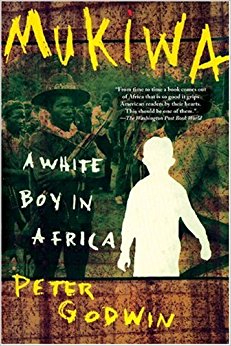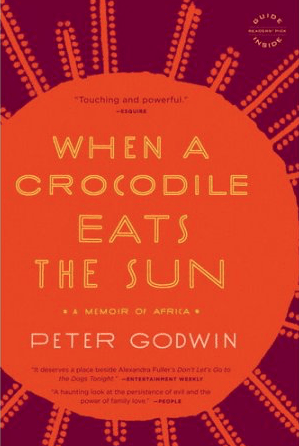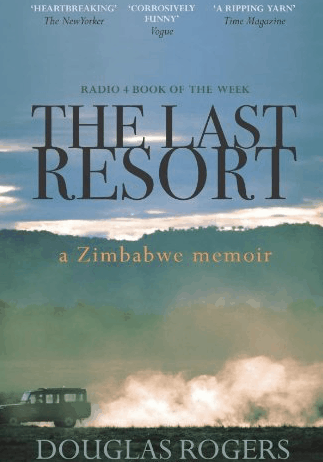White Africans Under Black Rule
Jon Harrison Sims, American Renaissance, September 2011
Peter Godwin, Mukiwa: A White Boy in Africa, Grove Press, 1996; 418 pp.
Peter Godwin, When a Crocodile Eats the Sun: A Memoir of Africa, Little, Brown, & Co., 2007, 341 pp.
Douglas Rogers, The Last Resort: A Memoir of Mischief and Mayhem on a Family Farm in Africa, Three Rivers Press, 2009, 317 pp.

Taken together, these three memoirs written by two white Africans, both natives of the country now called Zimbabwe, provide a haunting picture of an Arcadian idyll destroyed by a band of thugs led by a tyrant named Robert Mugabe. They offer many lessons.
Both authors are émigrés who now live in New York City. They were born just ten years apart — Mr. Godwin in 1957, Mr. Rogers in 1968 — but grew up in very different eras. Mr. Godwin was a boy during the mostly peaceful 1960s; Mr. Rogers during the violent 1970s. Both were raised in the Eastern Highlands, a place Mr. Godwin calls one of the most beautiful in all of Africa. Mr. Godwin’s parents were English, and emigrated to Rhodesia after the Second World War. By contrast, Mr. Rogers’s parents had deep roots in Africa. Rhodesia was home to the parents of both men, and all four were determined to stay.
Peter Godwin fought in the Bush War, the 15-year counter-insurgency against black nationalists supported by neighboring Mozambique and several Communist countries. At one time he led a platoon of the Rhodesian African Rifles, black troops with white officers. He attended Cambridge University and returned to Rhodesia as a foreign correspondent for the London Sunday Times just after the end of white rule in 1980.
Mr. Godwin single-handedly broke the story of the massacres in southwestern Zimbabwe in 1982-83. President Robert Mugabe, a member of the Mashona tribe, had sent his North Korean-trained elite Fifth Brigade into Matabeleland in the southeastern part of the country to terrorize the Ndebele people, who were of the same tribe as his political rival, Joshua Nkomo. Mr. Godwin found clear evidence of gang rape, torture, and mass murder of as many as 30,000 Ndebele. After his articles appeared, he had to flee the country, and this is where his first volume of memoirs ends.
Mr. Godwin’s account of his early boyhood reminded me of stories from my father about growing up in the American South during the 1940s and early ’50s. There was no crime to speak of, and race relations were close and harmonious. The white community was tight-knit and supportive, and everyone seemed to know everyone else. Minority status served to create a powerful social bond. There was no unemployment, and every adult worked.
The climate, the flora, and the fauna were, of course, different from the American South. The days were hot, with a blazing sun, but the nights were cool. The reason was altitude. Much of Rhodesia, including the capital city Salisbury and nearly all the white farming areas, was three- to five-thousand feet above sea level. For a boy, Rhodesia was paradise — day after day of glorious sunshine, exotic animals, a wilderness to explore, and very little adult supervision. The nights were black and filled with stars. There were dangerous animals, but children were taught about them and were soon self-reliant.
Mr. Godwin and his family used to vacation in neighboring Mozambique, and young Peter met some of the Portuguese troops who were fighting the insurgency that ended in 1975. The soldiers were mostly young conscripts, and very nervous about being in Africa. “Pedro, Pedro,” they would say, “tell us about Africa, tell us about the bush.” He would warn them of how protective lionesses were of their cubs, of stealthy crocodiles lurking in shallow water, of raging hippos with foot-long front teeth, poisonous puff adders, spitting cobras, and diseases like malaria and bilharzia. He explained that if they took precautions and paid attention, they would be fine. Instead, he terrified them, and their commanding officer complained to young Peter’s father that the green troops now all wanted to desert.

Mr. Godwin’s second volume of memoirs is about that very different country — Zimbabwe — that Rhodesia turned into after black rule began in 1979. Mr. Godwin traveled to Zimbabwe in July 1996 to help care for his aging parents, and came back often until his father’s death in 2004. He therefore witnessed the confiscation program that ran from 2000 through 2006 and that drove nearly every white farmer off the land.
Truckloads of machete-bearing, club-wielding thugs would drive onto the farms in military vehicles, singing songs or shouting political slogans. They would jump out and order the white farm families and black farm workers off the property. Many claimed — often falsely — to be wovits (short for “war vets”), and thus entitled to the land because they had fought in the insurgency that ended white rule. Those who were obviously too young to be wovits claimed to be members of the youth militia. Wovit commanders gave themselves names like Hitler Hunzvi, Stalin Mao Mao, and Comrade Satan.
Most white families fled in terror at the arrival of these mobs, leaving behind not only furniture and household goods but photo albums, family heirlooms, personal papers, and even passports and birth certificates. Farmers who resisted were beaten, and a few were killed. The blacks who worked the property — often hundreds of people, including dependents — were turned out to scavenge or starve.
Although Mr. Mugabe promised to distribute “liberated” farms to the people, most went to high-ranking members of the ruling party: generals, judges, diplomats, even bishops, none of whom knew how to farm or wanted to learn. On a visit to such a farm, Mr. Godwin watched the new owner, a certain Major Kanouruka, sitting on his veranda, barbecuing meat and draining a bottle of Glen Fiddich. Mr. Godwin noted that:
The fifty acres of citrus trees are wilting and will soon die. The irrigation piping on which they depend has been dug up and sold by the major’s boys. The greenhouses are nothing now but torn skeins of plastic that flap in the stiff breeze against their exposed wooden ribs. . . . The swimming pool is dark with rotting leaves. The clay tennis court has sprouted a quiff of elephant grass. Goats nibble at the lawn, and the flower beds are rapidly returning to bush.
The major also confiscated the farm’s bakery and meat business, sold off its flour and beef, leaving hundreds more black workers without jobs.
Mr. Mugabe explained the expropriations: “If white settlers just took the land from us without paying for it, we can in a similar way just take it from them without paying for it.” However, this reasoning was wrong. Mr. Godwin points out that in 2000, “78 percent of white farmers were on property they had purchased after independence,” that is to say, after the establishment of black rule. This meant that not only did they not steal the land, they had legal title to it under Zimbabwean law.
The British had funded a voluntary land redistribution program that began in 1980, and many whites sold their land to the government. By 2000, 40 percent of the land whites had owned in 1980 had been transferred to new owners. Whites could buy land from the government if there were no black buyers, or from the new owners, and many did so, thus establishing title. Some white farmers therefore actually took the wovits to court, and a few brave judges ruled in their favor — only to find themselves subject to the same violence and intimidation the farmers faced.
The consequence of hundreds of confiscations was the collapse of the agricultural sector, a pillar of the economy and the chief source of foreign exchange. Zimbabwe’s white farmers had fed much of southern Africa, employed two million black farm workers, and built and maintained much of the rural infrastructure of clinics and schools. The government destroyed all this and built nothing to replace it. By 2006, unemployment was at 80 percent, and Zimbabwe was suffering chronic food shortages.
The city rots
When Mr. Godwin started visiting his parents again, they were living in the capital, Harare (known as Salisbury under white rule). Mr. Godwin was amazed at the physical deterioration of the city, but things got worse with each visit: food and fuel shortages, bread lines, power outages, hyper-inflation, and increasing crime. On one trip, he found that the city’s street signs had disappeared because people stole them to sell as scrap metal. On another visit, he learned that his father had been carjacked and beaten in his own driveway. His parents suspected off-duty policemen or even soldiers. His father recovered physically, but was never the same, psychologically. Inflation wiped out his father’s bank account, life insurance policy, Zimbabwean bonds, and his mother’s government pension (she was a doctor, his father an engineer). Mr. Godwin had to find fuel and food for them on the black market.
On another visit, he went to his older sister’s grave to lay flowers, and found that a nearby township had overflowed into the cemetery. There were footpaths between the graves, patches of cultivated corn, and a rank, open-air latrine. Squatters had torn off the brass plaques that identified the tombs that held cremated remains. Some blacks had even broken into the tombs to steal the ash urns to use as cooking pots. The plaque on Mr. Godwin’s sister’s tomb was missing, so he could not find it. After returning from the cemetery office with the tomb number, he found that a woman working on a garden plot nearby had just defecated at the foot of his sister’s grave. He cursed and the women laughed. “The whole way of death is collapsing, just like the way of life,” he wrote angrily. Mr. Godwin’s second volume ends with his father’s cremation. A year or so later, his mother moved back to England to live with Mr. Godwin’s younger sister.
Most whites who can afford to have fled. From a peak population in 1970 of about 270,000 (some estimates are larger) the white population fell to fewer than 50,000 in 2002, and to not even 30,000 holdouts by the end of the decade.
The Saga of Drifters

Douglas Rogers’s book complements Mr. Godwin’s, as it describes his parents’ struggles to survive in rural Zimbabwe. His father was a non-practicing lawyer, who bought a 730-acre hill-top spread in the Eastern Highlands in 1990, that is to say, a decade after the beginning of black rule. His father’s life savings went into buying antelope, elands, impala, kudu, and bushbuck to stock a private game park. He also built a lodge, with magnificent views of mountains formed of granite:
A handsome two-story timber and brick structure with a cathedral spire of a thatched roof, it had an open-plan restaurant and bar on the top floor and sweeping saligna wood decks out front and back. The front deck overlooked a ceiling of acacia trees and the lush farms in the valley below. On the ground floor were a kitchen, rows of bunk beds for backpackers, and an art gallery; on newly planted lawns surrounding the lodge were a campsite and a dozen thatched chalets modeled on African huts, all set around a gleaming swimming pool that glowed luminous blue at night under the valley moon.
Known as Drifters, the game park prospered. It attracted young hikers and adventurers from around the world. It also became a regular hangout for the white farmers in the valley and for residents of the nearby town of Mutare.
Everything changed after the farm invasions began in 2000. The reign of terror scared away the travelers, and wovits confiscated all the white farms in the area. The new black owners living near Drifters cut down its fences to sell for scrap, shot and ate the game animals, and robbed his chalets of televisions, bedding, and furniture.
In 2005, a law cancelled the deeds to all farms, and the senior Mr. Rogers learned he had lost title to his property. He thought Drifters was exempt because it was not a farm, but when he went to the Registrar of Deeds he found that his deed was stamped: “This property now vests in the President of Zimbabwe.” That meant that any day some official could show up at the front door, and order the family off its property.
How Rogers’s parents managed to hold on to their land and start earning money from it furnishes much of the interest of the story. The key to survival was to stay on good terms with the local blacks. Mr. Rogers’s father wisely agreed to let an enterprising and intelligent black man with important government connections manage Drifters. This young man wangled enough liquor to restock the bar, and found fresh linens for the cottages and food for the restaurant. He then started renting out the cottages as love nests where generals, members of parliament, officials, and businessmen could take their mistresses.
Because Drifters was one of the few places in the country with a supply of cold beer, it became a popular, profitable watering-hole. Later in the decade, after diamond fields were discovered, diamond smugglers would meet and stay there. They were loaded with hard currency, and Drifters made more money than ever before.
Finally both Mr. Rogers and his son continued to cultivate good relationships with two key political figures: a local ZANU-PF official, and a decorated war veteran with connections to President Mugabe. The wovit promised to protect the family, and the ZANU-PF official, who had the power to take their ranch at any time, let them stay.
At the time the book appeared, the family was still managing Drifters!
Lessons for Whites
There is a saying common among Africans: “The worst thing to happen to Africa was the arrival of the white man. And the second worst was his departure.” Zimbabwe is a dramatic example: In Rhodesia in 1980, the year white rule ended, life expectancy was 57 years. In 2004, it had fallen to 34. Per capita income fell by half during the same period. Unemployment is now 80 percent.
When Peter Godwin was flying into Harare in April 2000, he sat next to an affable Congolese businessman who confessed to him, unbidden: “Africans can’t do governments. We are useless at it, disorganized. And our institutions never work . . . .”
Mr. Godwin is, himself, a chastened liberal. In 1980 and 1981, he shared the common hope that majority black rule, with the government’s policy of “reconciliation between races and between tribes,” would “help create a multi-racial society that would be the envy of Africa.” He “reveled in that brief and liberating period of social anarchy that marked the change between societies,” and “loved the bizarre mix of people” who came to the new Zimbabwe: “the Scandinavian sandal brigade and the Third World groupies, the sudden flood of communist diplomats.” Bob Marley, Paul Simon, and Michael Jackson came to Harare, and Mr. Godwin heard them sing the song of the new Africa. The singing did not last. “In 1982, less than two years after independence, the thin membrane of the tribal alliance ripped apart, just as the white doomsayers had eagerly warned it would,” he writes, and the Shona-Ndebele massacres began.
Mr. Godwin notes the futility of western aid projects, and describes the “life cycle of the First-World aid worker,” in which initial enthusiasm gives way to “messianism,” followed by disillusion and despair. He notes the perverse effects of western medicine: overpopulation in a continent that used to be underpopulated. He wonders if it might not have been better to leave Africa entirely to itself: “The whole idea of progress is a paradox, a rocking horse that goes forward and back, forward and back, but stays in the same place, giving only the comforting illusion of motion.”
He even begins to glimpse the truth when he writes of “a shiver of negative epiphany that we will never truly surmount race here.” On a visit to Cape Town, he realizes that this far, southwestern corner of Africa has a Southern European climate and doesn’t “feel like part of Africa.” He adds:
It sometimes feels to me as though Cape Town might also serve as the white man’s last redoubt where our vanguard will hold back the onslaught . . . while our women and children board lifeboats out to the tall ships waiting in False Bay . . . [to take] us back to England and Holland and France and Germany, or . . . North America and the Antipodes.
That he would write this sentence shows how the experience of being a vulnerable minority has kindled a sense of racial consciousness in this brave Anglo-African.
Whites everywhere naively assume that if non-whites become the majority they will stick to the non-discriminatory, “we are all the same,” rhetoric that whites believe. Zimbabwe teaches us that they may do the very opposite, and practice the most brutal forms of dispossession.















